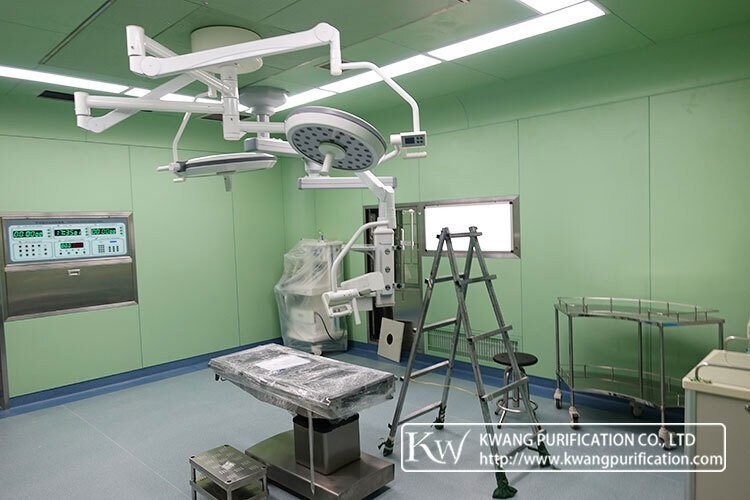Hospital Operating Clean Room: Ensuring Patient Safety and Sterility
- 2024-01-04
- View 11
Hospital operating clean rooms are essential for the safety of patients, as well as the healthcare professionals who perform surgeries. The presence of microorganisms can increase the risk of infections, which can be detrimental to the health of patients Clean rooms have a controlled environment that minimizes the presence of these microorganisms and other contaminants.

Surgical procedures require a sterile environment, and clean rooms provide this environment. They help to prevent airborne contamination, which can lead to surgical site infections. Surgical site infections can be serious and lead to further complications, which can prolong recovery time and increase the cost of treatment.
Designing Hospital Operating Clean Rooms:
The design of hospital operating clean rooms is critical to their effectiveness. The design should be based on the needs of the hospital and the types of surgical procedures that will be performed. The layout of the clean room should allow for easy movement of people and equipment, and should minimize the risk of contamination.
The Importance of Clean Rooms in Hospitals
Clean rooms play a crucial role in preventing infections and protecting patients in hospitals. They are designed to control airborne particles, such as bacteria, viruses, and fungi, as well as temperature, humidity, and air pressure, to provide a clean and sterile environment for medical procedures. Hospital operating clean rooms are especially important, as they are where surgical procedures take place and where patients are most vulnerable to infections. Here are some key reasons why clean rooms are essential in hospitals:
Reducing the risk of infection
Clean rooms are designed to minimize the risk of infection by controlling the concentration of airborne particles in the room. By limiting the number of particles, the risk of infection is significantly reduced, making the environment safer for both patients and medical staff.
Maintaining a sterile environment
Clean rooms are kept sterile by controlling the temperature, humidity, and air pressure. These factors are critical for maintaining a clean environment that is free from bacteria, viruses, and other contaminants that can cause infection.
Enhancing patient safety
Operating clean rooms are used for surgical procedures, which are inherently risky. By providing a sterile environment, clean rooms enhance patient safety by reducing the risk of infection and ensuring that procedures are conducted in a clean and controlled environment.
Reducing the risk of contamination
Clean rooms also help to prevent cross-contamination between patients, medical staff, and equipment. This is especially important in hospitals, where patients may have weakened immune systems and are more susceptible to infections.
Complying with regulatory requirements
Hospitals are subject to strict regulatory requirements, including guidelines set by the Centers for Disease Control and Prevention (CDC), the World Health Organization (WHO), and other governing bodies. Clean rooms help hospitals comply with these requirements by providing a sterile environment for medical procedures.
Conclusion
Operating clean rooms are an essential component of modern healthcare facilities. The benefits of having a clean environment in operating rooms are numerous, including reduced infection rates, improved patient outcomes, enhanced safety for medical personnel, compliance with regulations, and an improved reputation for the hospital. By investing in clean rooms, hospitals can provide safer and more effective care for their patients.
FAQs
What is a clean room in a hospital operating room?
A clean room is a controlled environment designed to reduce the number of airborne particles and bacteria in the air. In a hospital operating room, clean rooms are used to reduce the risk of infections during surgeries.
How is a clean room in a hospital operating room different from a regular operating room?
Clean rooms are designed to control the air quality, while regular operating rooms are not. Clean rooms use specialized equipment such as HEPA filters to remove airborne particles and bacteria, while regular operating rooms do not have this equipment.
What are some of the contaminants that can be present in a hospital operating room?
Contaminants in a hospital operating room can include bacteria, viruses, mold spores, and other airborne particles.
What regulations govern clean rooms in hospital operating rooms?
The Centers for Disease Control and Prevention (CDC) and the Occupational Safety and Health Administration (OSHA) set regulations and standards for clean rooms in hospital operating rooms.
How can hospitals maintain the cleanliness of their operating rooms?
Hospitals can maintain the cleanliness of their operating rooms by following strict cleaning protocols, using specialized equipment such as HEPA filters, and training their staff on proper cleaning procedures.
More of your interest
Cleanroom Design And Layout Considerations
What Is a Cleanroom And Benefits of a Cleanroom
Pharmaceutical Factory Air Purification System
